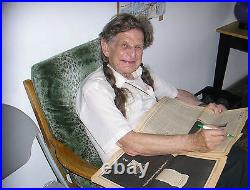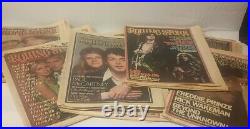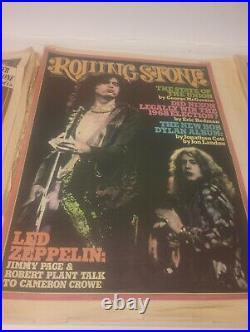





I got the “Counter-Culture Hero” L. Free Press Editor Art Kunkin to sign this 9/3/71 Free Press Cover & Article ONLY! Featuring an interview w/Timothy Leary out in the Joshua Tree Area of the’High Desert’ of Southern Calif. At the Radio Free Joshua Tree Lounge. ” He also signed an 8 1/2″ X 11″ reproduction of the “Timothy Leary 4 Governor poster/Timothy Leary Benefit Freep Ad. Included is a (same size) reproduction of the photo of the moment Timothy Leary was arrested outside of the L. Freep office by the feds, while Art Kunkin looks on.. Please Read Wikipedia Articles Below, to Learn More About How Much He’s Done For the Real Progressive Movement over the Last 4 to 5 Decades.. (From Wikipedia) Arthur Glick’Art’ Kunkin (born 1928) is an American journalist. Best known as the founding publisher and editor of the Los Angeles Free Press. Born in New York City. He attended the prestigious Bronx High School of Science. And the New School for Social Research. Eventually becoming a tool and die maker. And joining the Trotskyite. Movement as an organizer for the Socialist Workers Party. Where he was business manager of the SWP paper, The Militant. Beginning in the late 1940s Kunkin was associated with C. L. R. And the radical Marxist Johnson-Forest Tendency. During the 1950s he was Los Angeles editor of their journals Correspondence. And News & Letters. While working as a master machinist and tool and die maker for Ford. During this period a number of theoreticians and organizers of the Johnson-Forest trend including Raya Dunayevskaya. Were concentrated in the auto industry in Detroit, where they worked to recruit black workers and gain influence inside the auto workers’ unions. In 1962 Kunkin left General Motors to go back to college and work toward a graduate degree. Soon afterward he had his first experience with a local newspaper on the staff of a Mexican-American paper in Los Angeles called the East L. “For the first time in my life I was writing about garbage collection and all kinds of community problems, ” he later recalled. Meanwhile, he was also doing political radio commentaries for KPFK. Pacifica Radio while serving as the Southern California district leader of the Socialist Party. In May 1964 he produced the first trial issue of the LA Free Press as a one-shot distributed at the Renaissance Pleasure Faire and May Market. A fund-raising event for KPFK. The response was favorable enough for Kunkin to start publishing the Freep (as it came to be called) on a regular basis starting in July. The core group of volunteers and supporters who got involved in the paper included people from KPFK, the bohemian crowd that hung out at the Papa Bach bookstore, and The Fifth Estate, a Sunset Strip. Coffee house which provided office space for the Freep in its basement. The paper soon became a nerve center of the burgeoning hippie scene. The atmosphere at the Freep was described by a reporter for Esquire. Kids, dogs, cats, barefoot waifs, teeny-boppers in see-through blouses, assorted losers, strangers, Indian chiefs wander in and out, while somewhere a radio plays endless rock music and people are loudly paged over an intercom system. It’s all very friendly and rather charming and ferociously informal. Launched on a shoestring budget, the Free Press struggled for years. By 1969 circulation had exploded to 100,000 copies, but legal problems stemming from publication of a list of names of undercover drug agents put the Freep in a precarious financial position just as it was expanding its operations to include a printing plant, a typesetting firm and a small chain of bookstores. Underpaid staff members left in two waves of defections to form the competing newspapers Tuesday’s Child. By 1972 Kunkin and the paper were deep in debt to the very pornographers whose advertising had been the source of the paper’s profits, and Kunkin lost control of the paper and was fired, rehired, and fired again, as the paper spiraled slowly into oblivion, paralleling the nationwide decline of the underground press. Kunkin’s post- Free Press career began with a stint as a professor of journalism at California State University, Northridge. Followed by several years as president of the Philosophical Research Society. In Los Angeles, an esoteric mystical group founded by Manly Palmer Hall. This was followed by an apprenticeship in alchemy. At the Paracelsus Research Society. In Salt Lake City. Where he edited their journal Essentia. He later became a lecturer in alchemy and other New Age topics at the Institute for Mentalphysics. Retreat center near Joshua Tree. And a columnist for the Desert Valley Star. Art Recently Received 2 “Lifetime Achievement Awards” from the Veterans for Peace AND the Calif. Please feel free to ask any questions. It Is Guaranteed To Be What Is Claimed: An Authentic Signed Piece of “Underground Newspaper Journalism History” Signed by 1 of the People Who Helped Start It All, Art Kunkin! The Article/Newspaper Itself is In Excellent Condition for Being Just Over 5 Decades Old- The Newsprint Is Not Brittle, & There Are No Tears, Rips, Holes, Etc… Only Slight Yellowing From Age.











